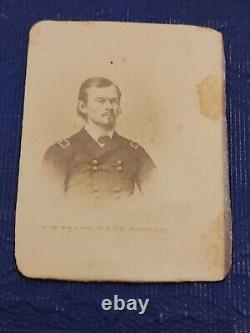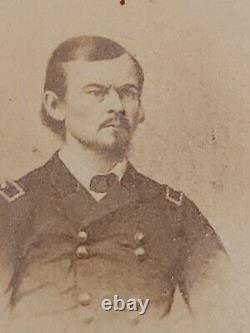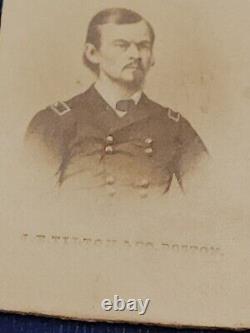Original Civil War Tilton Albumin Photo Union General SIGEL 1- 13/16






Original Civil War Tilton Albumin Photo Union General FRANZ SIGEL. 1 13/16" x 1 3/8".
Albumin photo published by J. , who reproduced photographs taken by James Wallace Black, among others. Tilton and Company was founded in Boston in 1859 by John E. Tilton and Stephen Willis Tilton. The firm went out of existence in 1874. Franz Sigel (November 18, 1824 - August 21, 1902) was a German American military officer, revolutionary and immigrant to the United States who was a teacher, newspaperman, politician, and served as a Union major general in the American Civil War. His ability to recruit German-speaking immigrants to the Union armies received the approval of President Abraham Lincoln, but he was strongly disliked by General-in-Chief Henry Halleck. Shortly after the start of the war, Sigel was commissioned colonel of the 3rd Missouri Infantry, a commission dating from 4 May 1861. He took part in the capture of Camp Jackson in St. Gen Nathaniel Lyon on 10 May.In the summer of 1861, President Lincoln actively sought the support of antislavery, pro-Unionist immigrants. Sigel, always popular with the German immigrants, was a good candidate to advance this plan. He was promoted to brigadier general on 7 August, to rank from 17 May, one of a number of early politician-generals elevated by Lincoln. In June, Sigel led a Federal column to Springfield in southwest Missouri. He then moved to Carthage, to cut off the retreat of pro-Confederate Missouri State Guard troops previously defeated by Lyon at Boonville.
In the subsequent Battle of Carthage on 5 July, Sigel's outnumbered force was driven back by the State Guard. The action was strategically insignificant, but did encourage pro-Confederate recruitment. Sigel then joined his troops with the army under Lyon, which marched to Springfield in pursuit of the State Guard. In the Battle of Wilson's Creek, on 10 August, he led a flanking column which attacked the rear of the rebel force, but was routed. After General Lyon was killed, Sigel assumed command of the army, and conducted the retreat to Rolla.
In early 1862, Sigel was given command of two divisions of the Army of the Southwest under Samuel R. The army moved through Springfield into Arkansas, and met Confederate troops under Maj. Earl Van Dorn in the Battle of Pea Ridge on 8-9 March. Sigel's finest performance was in this battle.
His troops fought well, and on 9 March he personally directed the Union artillery in the attack which routed the Confederates. Sigel was promoted to major general on 21 March 1862. He served as a division commander in the Shenandoah Valley and fought unsuccessfully against Maj. "Stonewall" Jackson, who outwitted and defeated the larger Union force in a number of small engagements.
He commanded the I Corps in Maj. John Pope's Army of Virginia at the Second Battle of Bull Run, another Union defeat, where he was wounded in the hand. Over the winter of 1862-63, Sigel commanded the XI Corps, consisting primarily of German immigrant soldiers, in the Army of the Potomac. When Ambrose Burnside assumed command of the Army of the Potomac, he instituted'grand divisions', consisting of two corps each; Sigel assumed command of the Reserve Grand Division, consisting of the XI and XII Corps.The Reserve Grand Division saw no action; it stayed in reserve during the Battle of Fredericksburg. He had developed a reputation as an inept general, but his ability to recruit and motivate German immigrants kept him employed in a politically sensitive position. Many of these soldiers could speak little English beyond "I'm going to fight mit Sigel", which was their proud slogan and which became one of the favorite songs of the war.
They were quite disgruntled when Sigel left the XI Corps in February 1863, and was replaced by Major-General Oliver O. Howard, who had no immigrant affinities. Fortunately for Sigel, the two black marks in the XI Corps' reputation-Chancellorsville and Gettysburg-would occur after he was relieved. The reason for Sigel's relief is unclear.
Some accounts cite failing health; others that he expressed his displeasure at the small size of his corps and asked to be relieved. Many historians also cite the lack of military prowess and skill [citation needed]. On multiple occasions, he made terrible military decisions[citation needed], resulting in deaths of his soldiers and also Nathaniel Lyon in 1861 at the Battle of Wilson's Creek.
Halleck detested Sigel, and managed to keep him relegated to light duty in eastern Pennsylvania until March 1864. President Lincoln, for political reasons, directed Secretary of War Edwin M. Stanton to place Sigel in command of the new Department of West Virginia.In his new command, Sigel opened the Valley Campaigns of 1864, launching an invasion of the Shenandoah Valley. He was soundly defeated by Maj. Breckinridge at the Battle of New Market, on May 15, 1864, which was particularly embarrassing due to the prominent role played by young cadets from the Virginia Military Institute. After the battle, Sigel was replaced by Maj.
In July, Sigel fought Lt. Early at Harpers Ferry, but soon afterward was replaced by Albion P.Sigel spent the rest of the war without an active command. This item is in the category "Collectibles\Militaria\Civil War (1861-65)\Original Period Items\Photographs". The seller is "uncorped" and is located in this country: US.
This item can be shipped to United States.
- Conflict: Civil War (1861-65)
- Original/Reproduction: Original
- Theme: Militaria
- Country/Region of Manufacture: United States


